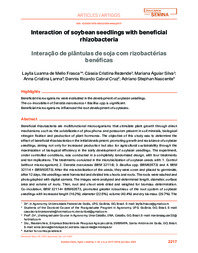Interaction of soybean seedlings with beneficial rhizobacteria.
Interaction of soybean seedlings with beneficial rhizobacteria.
Author(s): FRASCA, L. L. de M.; REZENDE, C. C.; SILVA, M. A.; LANNA, A. C.; CRUZ, D. R. C.; NASCENTE, A. S.
Summary: Beneficial rhizobacteria are multifunctional microorganisms that stimulate plant growth through direct mechanisms such as the solubilization of phosphorus and potassium present in soil minerals, biological nitrogen fixation and production of plant hormones. The objective of this study was to determine the effect of beneficial rhizobacteria on the initial development, promoting growth and resistance of soybean seedlings, aiming not only for increased production but also for agricultural sustainability through the maximization of biological efficiency in the early development of soybean seedlings. The experiment, under controlled conditions, was conducted in a completely randomized design, with four treatments and ten replications. The treatments consisted in the microbiolization of soybean seeds with: 1. Control (without microorganism); 2. Serratia marcenses (BRM 32114); 3. Bacillus spp. (BRM63573) and 4. BRM 32114 + (BRM63573). After the microbiolization of the seeds, they were sown and placed to germinate, after 12 days, the seedlings were harvested and divided into shoots and roots. The roots were washed and photographed with digital camera. The images were analyzed and determined length, diameter, surface area and volume of roots. Then, root and shoot were dried and weighed for biomass determination. Co-inculation, BRM 32114+ BRM63573, promoted greater robustness of the root system of soybean seedlings with increased length (16.2%), diameter (22.5%), volume (43.4%) and dry biomass (29.7%). The dry matter of shoots and total soybean seedlings was superior to the control treatment in all treatments with rhizobacteria. Therefore, plant growth promoting rhizobacteria are considered promising technology to provide greater development of soybean seedlings.
Publication year: 2023
Types of publication: Journal article
Unit: Embrapa Rice & Beans
Observation
Some of Embrapa's publications are published as ePub files. To read them, use or download one of the following free software options to your computer or mobile device. Android: Google Play Books; IOS: iBooks; Windows and Linux: Calibre.
Access other publications
Access the Agricultural Research Database (BDPA) to consult Embrapa's full library collection and records.
Visit Embrapa Bookstore to purchase books and other publications sold by Embrapa.

